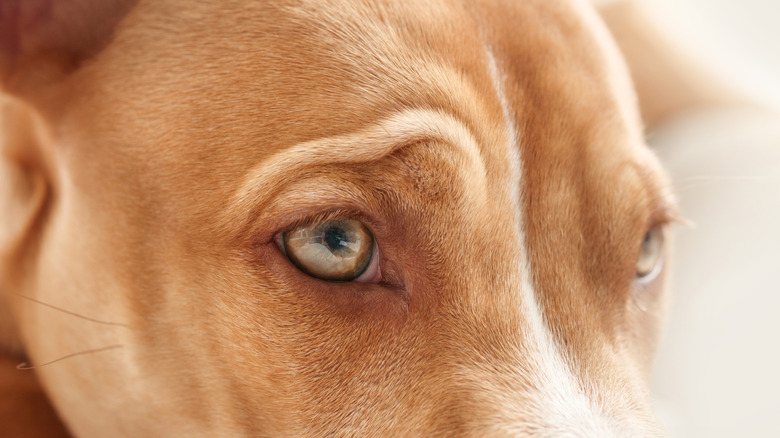Pit Bull Eye Problems: Common Conditions And Symptoms
Pit bull eyes are prone to few genetic disorders, but the breed can also suffer from other eye conditions common to many dog breeds. There are three main breeds that are generally referred to as pit bulls: the American pit bull terrier, the Staffordshire bull terrier, and the American Staffordshire terrier. Unfortunately, all of these breeds are prone to similar genetic pit bull eye problems.
Common pit bull eye diseases
The American pit bull, a breed recognized by the United Kennel Club, is genetically prone to a few eye diseases and abnormalities:
- PPMs — persistent pupillary membrane
- Retinal atrophy (crd2, CRD1/rcd1b) — autosomal recessive, DNA tests available (IQCB1 or PDE6B gene mutation)
- Retinal dysplasia
Progressive retinal atrophy is also a common concern. While the disease isn't painful for the dog, it causes incurable blindness. The first symptoms usually occur in most dog breeds between 3 and 5 years old. However, in pit bulls, the condition can occur much earlier, specifically in juveniles as young as 1 year old. Indications of this condition are dilated pupils or night blindness.
Another genetic condition that may occur in pit bulls is a progressive neurological condition called neuronal ceroid lipofuscinosis. The primary symptoms include weakness in the hind legs and a lack of balance. However, as the disease worsens, dogs can lose their sight, although this is not widely reported in this breed. There is no cure for either of these diseases, but a genetic test for both of these health problems is available.
Staffordshire bull terrier eye problems
Three eye conditions common in Staffordshire bull terriers are the following:
- Juvenile hereditary cataracts
- Persistent hyperplastic primary vitreous (PHPV)
- Distichiasis
Testing is available for the first two conditions.
Juvenile hereditary cataracts usually appear when the dog is between 1 and 3 years old and usually affect both eyes. It appears as cloudiness in the eye as a result of tissue breakdown. In some dogs, it progresses slowly, while others experience a rapid progression of the disease. Dogs lose the ability to see clearly and in some cases go completely blind. Surgery is possible but is not always effective.
PHPV is a developmental problem that occurs while the puppy is still an embryo. While the embryo is developing, there are blood vessels in the eye that are reabsorbed in healthy dogs. However, the blood vessels remain in dogs with PHPV, obscuring the dog's vision and sometimes causing total blindness.
Veterinarians typically diagnose PHPV when the puppy is 8 to 12 weeks of age. If the condition is severe, your veterinarian might recommend surgery and regular checkups.
American Staffordshire terrier eye problems
The American Staffordshire terrier can suffer from the following inherited eye conditions:
- Cataracts
- Ceroid lipofuscinosis — autosomal recessive, DNA test available (ARSG gene mutation)
- Distichiasis
- Entropion
- Persistent corneal erosion
- Persistent hyperplastic primary vitreous (PHPV) PPMs
- Retinal atrophy (crd2, CRD1/rcd1b) — autosomal recessive, DNA tests available (IQCB1 or PDE6B gene mutation)
- Retinal dysplasia
Two eye conditions that the American Staffordshire terrier might suffer from include distichiasis and entropion (these are also seen in other breeds). Entropion occurs when the eyelid curls toward the eye, bringing the lashes in contact with the eyeball, and distichiasis is a condition where the dog grows extra eyelashes or hair on the inside of the eyelid. Both conditions cause the hairs to rub against the cornea of the eye, causing irritation, pain, and potential loss of sight.
Other conditions that affect pit bull eyes
Other conditions and diseases that are common to all dogs also affect the pit bull. For example, conjunctivitis, or pink eye, is a condition that dogs may contract. It can be caused by allergies or bacterial infections, and the treatment will depend on the underlying cause. Pit bulls, like all dogs, can also injure or scratch their cornea. This might happen when they paw their face or as a result of grass or foreign bodies in their eye.
Pit bulls may also get nonhereditary cataracts as they age, causing cloudy eyes, inflammation, and loss of sight. Glaucoma, most likely in older dogs, is another condition that can lead to sight loss. It occurs when the fluid in the dog's eye doesn't drain properly, causing high amounts of pressure inside the eye. Possible treatment options include medication and surgery.
If you notice any abnormal dog eye problems, whether that be redness, dry eye, cherry eye, inflammation, discharge, or excessive blinking, or if you suspect your dog cannot see clearly, contact your veterinarian right away. Once your DVM (veterinarian) diagnoses the problem, you can determine the best treatment options for your pup, which might include a visit to the veterinary ophthalmologist to treat these health issues.
The bottom line
Pit bull is not a specific breed but rather a general term usually referring to either the American pit bull or the Staffordshire bull terrier. Unfortunately, all pit bull breeds of dogs are prone to genetic eye diseases, including distichiasis, entropion, progressive retinal atrophy, juvenile hereditary cataracts, and persistent hyperplastic primary vitreous. The results of these diseases range from mild to complete sight loss in affected dogs. Testing is available for several hereditary canine eye conditions. Treatments range from eye drops and ointments to surgery depending on the specific health issue. Other pit bull eye problems include issues that impact all dogs, such as conjunctivitis, dog eye infections, and cornea scratches.


